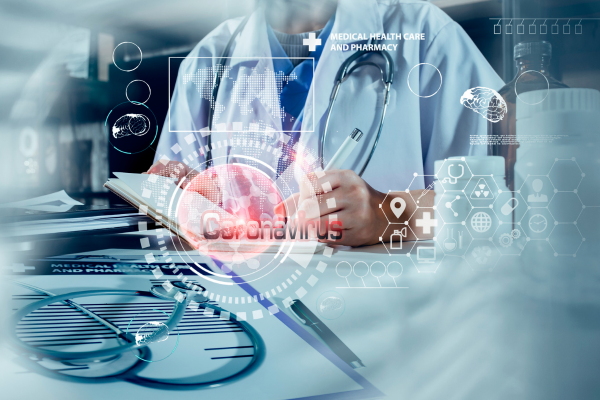Introduction
Alright, let’s dive into the fascinating world of healthcare IT! Imagine a world where your health data is just a click away, where doctors can diagnose you from miles away, and where your watch reminds you to stay active. That’s the magic of healthcare IT, and we’re about to uncover all its secrets.
Electronic Health Records (EHRs): The Digital Lifesaver
Imagine a world where your medical records are no longer scattered across various paper documents and filing cabinets but are instead neatly organized in a digital file accessible with a few clicks. Welcome to the world of Electronic Health Records (EHRs), a true digital lifesaver in the realm of healthcare IT.
- Boosting Patient Care: Think of EHRs as a physician’s trusty sidekick. These digital records provide doctors with rapid access to your medical information. When you visit a doctor, they can quickly pull up your EHR, giving them a comprehensive view of your medical history. This means they don’t have to rely solely on your memory or wait for physical records to be retrieved. With all your information at their fingertips, they can make more informed decisions about your health. This can be especially critical in emergencies when time is of the essence.
- Connecting the Dots: EHRs are like the ultimate communicators in the healthcare world. They facilitate seamless information sharing between different healthcare providers involved in your care. This means that your primary care physician, specialists, pharmacists, and even healthcare facilities like hospitals can all access the same set of records. This interconnectedness ensures that everyone is on the same page when it comes to your health. For instance, if you’re seeing a specialist, they can review your EHR to understand your medical history and any ongoing treatments. This coordination helps prevent duplication of tests and treatments, ultimately leading to better and more efficient healthcare.
- Uncovering Insights: EHRs are like data detectives. They don’t just store your medical history; they also analyze it. Imagine if your records could reveal patterns and trends in your health. EHRs can do just that. By sifting through vast amounts of patient data, these systems can identify trends and correlations that might not be obvious to a human eye. For example, they can detect if certain treatments are consistently more effective for patients with specific characteristics. This analytical power can lead to more personalized and effective treatments. Additionally, EHRs can provide insights at a population level, helping healthcare organizations identify and address public health issues.
Telehealth and Telemedicine: Doctor’s Appointments in Your Pajamas
Telehealth and telemedicine have revolutionized the way we access healthcare services, essentially placing a virtual doctor right in your pocket. These innovative approaches leverage technologies such as video calls, mobile apps, and wearable devices to deliver a range of healthcare benefits:
- Bringing Healthcare Home: The traditional routine of scheduling an appointment, traveling to the clinic, and waiting in line is no longer the only option. Telehealth and telemedicine allow you to consult with your healthcare provider from the comfort of your own home. Whether you’re dealing with a minor ailment, seeking medical advice, or managing a chronic condition, a virtual visit can be as effective as an in-person one. This convenience is especially valuable for those living in remote areas or individuals with mobility challenges.
- Saving Bucks: Telehealth and telemedicine can be a financial lifesaver. By reducing the need for frequent in-person visits, both patients and healthcare providers can save money. Patients spend less on transportation, parking, and sometimes childcare expenses. Doctors, on the other hand, benefit from increased efficiency, fewer administrative costs, and potentially being able to see more patients in a day. It’s a win-win situation that not only saves money but also time.
- Managing Chronic Illness: For individuals with chronic health conditions like diabetes, hypertension, or asthma, telehealth and telemedicine are game-changers. These platforms offer continuous monitoring and management options. Patients can use wearable devices to track vital signs like blood pressure, blood sugar levels, or heart rate. The data collected is then transmitted to healthcare providers who can remotely assess the patient’s condition and make necessary adjustments to treatment plans. This proactive approach to chronic disease management can lead to better health outcomes and a higher quality of life.
Health Information Exchanges (HIEs): The Seamless Health Record Movers
Imagine this scenario: You move to a new city or state, find a new healthcare provider, and they ask for your medical history. You’ve got to recount every procedure, every medication, and every allergy you’ve ever had. It’s a frustrating and potentially dangerous situation. This is where Health Information Exchanges (HIEs) come into play, acting as the heroes of healthcare IT. Here’s how they work their magic:
- No More Redundant Tests: How many times have you had to redo the same medical tests when switching doctors or healthcare facilities? HIEs put an end to this redundancy. When you move or need to consult a new specialist, your medical records move with you. Your new doctor can access your complete medical history, including test results, diagnoses, and treatment plans. This means no more unnecessary tests, fewer expenses, and a faster path to the right treatment.
- Better Teamwork: In the world of medicine, teamwork is vital. Many patients receive care from various specialists, and coordinating their efforts is crucial for your well-being. HIEs allow different healthcare providers to access the same comprehensive patient record. Whether you’re seeing a primary care physician, a cardiologist, or a dermatologist, they can all view your complete medical history. This fosters collaboration, ensures everyone is on the same page, and leads to more effective and coordinated care.
- Lifesaver in Emergencies: Imagine a critical medical situation—a sudden illness, a severe accident, or an unexpected allergic reaction. In such emergencies, every second counts. HIEs can be genuine lifesavers in these scenarios. When you’re unable to provide your medical history due to the urgency of the situation, healthcare providers can access your vital health information through the HIE. This quick access can make the difference between life and death. It empowers doctors to make informed decisions, avoid harmful drug interactions, and provide appropriate treatments promptly.
AI in Healthcare: The Smart Revolution
Artificial Intelligence (AI) is no longer the stuff of science fiction; it’s become a powerful ally in the healthcare sector, making medical practices smarter and more efficient. Let’s explore how AI is transforming the landscape of healthcare:
- Diagnosis Booster: Imagine an AI system that can analyze medical images with unparalleled precision and speed. This is a reality today. AI algorithms are trained to detect abnormalities in medical images, such as X-rays, MRIs, and CT scans. They can identify the earliest signs of diseases, even before they’re visible to the human eye. For instance, AI can help radiologists pinpoint tiny lung nodules that might indicate the presence of lung cancer or detect subtle changes in mammograms, potentially catching breast cancer at an earlier, more treatable stage. By acting as a diligent assistant to healthcare professionals, AI significantly enhances the accuracy and speed of diagnoses, leading to more timely interventions and better patient outcomes.
- Drug Discoverer: Developing new medications is a lengthy and expensive process. AI is changing the game by expediting drug discovery. AI-driven algorithms can analyze vast datasets of chemical compounds, predict their potential interactions with biological targets, and forecast which compounds are most likely to become effective drugs. This accelerates the search for novel medicines to treat various diseases, from cancer to rare genetic disorders. By significantly shortening the drug development timeline, AI not only saves time and resources but also offers hope to patients awaiting groundbreaking treatments.
- Personal Health Guru: Your health is personal, and AI understands that. It can harness the power of your medical history, genetic information, lifestyle data, and even real-time health metrics from wearable devices to create highly personalized treatment plans. These plans consider your unique needs, preferences, and risk factors. For example, if you’re managing a chronic condition like diabetes, AI can help you monitor your blood glucose levels, suggest dietary adjustments, and even provide medication reminders. It’s like having a personal health coach that’s available 24/7. By tailoring healthcare recommendations to individual patients, AI ensures that treatments are more effective and patient-centric.
Wearable Technology: Your Health Companion
Fitness trackers and smartwatches have evolved far beyond merely counting steps or telling time. Today, they’re your loyal companions in the journey toward better health and well-being. Let’s dive into how these wearables are revolutionizing personal health management:
- Health Checkup: Wearables are like your personal health detectives. Equipped with advanced sensors, they continuously monitor vital signs like heart rate, sleep patterns, and even blood oxygen levels. This data offers invaluable insights into your overall health. For instance, a fitness tracker can provide a comprehensive overview of your daily physical activity, showing not just how many steps you’ve taken but also how many calories you’ve burned, how long you’ve been active, and even the intensity of your workouts. Smartwatches often include electrocardiogram (ECG) sensors, enabling you to record and analyze your heart’s electrical activity, potentially detecting irregularities or conditions like atrial fibrillation. By offering real-time health metrics, wearables empower you to proactively manage your well-being.
- Motivation Guru: Achieving health and fitness goals can be challenging, but wearables act as your personal motivators. They visualize your progress through user-friendly interfaces and mobile apps. Seeing your steps increase, your heart rate drop, or your sleep quality improve in real-time can be incredibly motivating. Many wearables set daily activity goals and reward you with virtual badges or notifications when you reach milestones. This gamification aspect makes health improvement more engaging and encourages you to make healthier choices. Plus, sharing your achievements with friends or participating in challenges within wearable apps can add a social element to your fitness journey, fostering a sense of community and friendly competition.
- Alert System: Wearables are more than just passive data collectors; they can actively watch over your health. Some wearables are equipped with fall detection features that can automatically send alerts to designated contacts or emergency services if a significant fall or impact is detected. They can also issue warnings when your heart rate or blood pressure spikes unexpectedly, potentially signaling a health issue that requires attention. In addition to real-time alerts, wearables can store your health data over time, creating a valuable historical record for both you and your healthcare provider. This historical data can help identify trends or anomalies in your health, aiding in early intervention and more informed medical consultations.
Cybersecurity in Healthcare: Safeguarding Your Most Personal Data
In an age when digital technology is deeply embedded in healthcare, ensuring the security of sensitive medical information has become paramount. The guardians of your health data are the cybersecurity measures that work tirelessly to keep it safe. Let’s delve into why this protection is essential and how it’s achieved:
1. No Data Heists: Cybersecurity Tools Protect Your Info from Hackers
Imagine a digital fortress around your personal health information. This fortress is guarded by cybersecurity tools armed with the latest technologies and techniques. Here’s how they protect your health data:
- Firewalls: These digital barriers act as sentinels, monitoring and controlling incoming and outgoing network traffic. They block unauthorized access and potential threats from hackers.
- Intrusion Detection Systems (IDS) and Intrusion Prevention Systems (IPS): IDS scans network traffic for suspicious activities or patterns. IPS takes it a step further by actively blocking or preventing unauthorized access or malicious activities.
- Antivirus Software: Just like a flu shot protects you from viruses, antivirus software detects, prevents, and removes malicious software or malware that could compromise your health data.
- Data Encryption: Your health records are often in transit between systems, such as when transferred from a healthcare provider to a specialist. Encryption scrambles this data into an unreadable format during transmission, ensuring that even if intercepted, it remains secure.
- Multi-Factor Authentication (MFA): MFA adds an extra layer of security by requiring users to provide two or more forms of identification before granting access. This makes it significantly more challenging for unauthorized individuals to gain entry.
Regular Updates and Patch Management: Cybersecurity professionals keep software and systems up to date with the latest security patches to close vulnerabilities that hackers could exploit.
2. Privacy Rules: Laws Like HIPAA Make Sure Your Medical Secrets Stay Secret
In the realm of healthcare, privacy is sacrosanct. That’s where laws like the Health Insurance Portability and Accountability Act (HIPAA) in the United States come into play. HIPAA sets stringent standards to safeguard patient privacy and protect health information from unauthorized access or disclosure. Here’s how HIPAA ensures your medical secrets remain secret:
- Privacy Rules: These rules dictate how healthcare providers and organizations handle patient data. They require consent before sharing information, limit the use of personal health information, and establish safeguards for data security.
- Security Standards: HIPAA mandates specific security measures, like encryption, to protect electronic health records (EHRs) and requires organizations to conduct risk assessments regularly.
- Breach Notification: In the event of a data breach, HIPAA requires healthcare organizations to notify affected individuals promptly. This transparency ensures patients are aware of potential risks.
- Penalties: HIPAA violations can result in hefty fines, civil lawsuits, and even criminal charges. These consequences serve as powerful deterrents against mishandling patient data.
3. Lock and Key: Data Encryption keeps Your Health Records Safe, Even When They’re in Transit
Imagine your health records as a treasure chest of sensitive information. While they’re on the move, like when transferred between your primary care physician and a specialist, they need protection. This is where data encryption serves as the digital lock and key:
- How It Works: Encryption transforms your health data into an unreadable format, known as ciphertext, using complex algorithms. Only authorized parties with the decryption key can revert it to its original, meaningful form.
- End-to-End Encryption: In healthcare, end-to-end encryption ensures that your data remains secure throughout its journey, from the sender to the recipient. Even if intercepted during transmission, the information remains indecipherable to prying eyes.
- Cloud Storage Encryption: Healthcare organizations often use cloud storage for the convenience of data access and sharing. Encryption ensures that data stored in the cloud remains confidential and secure.
- Mobile Device Encryption: With healthcare providers increasingly relying on mobile devices for patient care, encryption on smartphones and tablets safeguards the data they handle.
Challenges and Future Trends: What Lies Ahead
As we explore the world of healthcare IT, it’s essential to recognize that while it offers incredible opportunities, it’s not without its fair share of challenges. However, with each challenge comes the potential for innovative solutions and exciting future trends that promise to revolutionize the healthcare industry.
1. Challenges in Healthcare IT
- Interoperability and Data Sharing: One of the persistent challenges in healthcare IT is the seamless sharing of data between different systems. Electronic Health Records (EHRs) and healthcare apps often struggle to communicate effectively, hindering the flow of critical patient information. This lack of interoperability can lead to delays in diagnosis and treatment.
- Data Security and Privacy: With the digitization of health records, ensuring robust data security and patient privacy has become paramount. Cyberattacks on healthcare systems are on the rise, putting sensitive medical data at risk. Staying ahead of cyber threats and maintaining compliance with privacy laws like HIPAA remains an ongoing challenge.
- Healthcare Disparities: While technology has the potential to improve healthcare accessibility, disparities still exist. Not everyone has equal access to telehealth services or the latest healthcare gadgets. Bridging this digital divide remains a challenge, particularly in underserved communities.
2. Futrue Trends in Healthcare IT
Despite these challenges, the future of healthcare IT is brimming with promise. Emerging trends and technologies are poised to reshape the healthcare landscape:
- Blockchain in Healthcare: Blockchain technology is gaining traction in healthcare for its potential to make data sharing more secure, transparent, and efficient. Patients will have greater control over their medical records, and healthcare providers can access accurate patient histories in real-time.
- 5G Technology: The rollout of 5G technology promises lightning-fast internet speeds, revolutionizing telehealth and the Internet of Things (IoT) in healthcare. Remote patient monitoring, telesurgery, and augmented reality (AR) for medical training are just a few areas set to benefit.
- Quantum Computing: Quantum computing is on the horizon, holding the promise of solving complex healthcare problems at unprecedented speeds. From drug discovery to genetic analysis, quantum computing has the potential to accelerate medical advancements.
- AI and Machine Learning: Artificial intelligence and machine learning will continue to play a significant role in healthcare. These technologies can analyze vast amounts of medical data, aiding in early disease detection, personalized treatment plans, and predicting patient outcomes.
- Telemedicine Evolution: Telehealth and telemedicine will continue to evolve, offering not only virtual consultations but also remote monitoring of chronic conditions. The integration of AI and wearable health devices will make remote healthcare even more comprehensive.
Conclusion
The world of healthcare IT is an exciting and dynamic one. While challenges persist, innovative solutions and emerging technologies are constantly pushing the boundaries of what’s possible in healthcare. As healthcare IT continues to evolve, it’s essential for healthcare providers, technology developers, and policymakers to work collaboratively to address challenges, ensure data security and privacy, and harness the full potential of these transformative trends. The future of healthcare is digital, and it’s a future brimming with possibilities for improved health outcomes and enhanced patient well-being.




